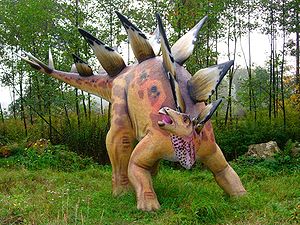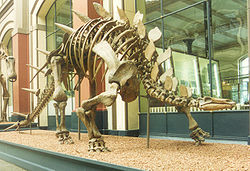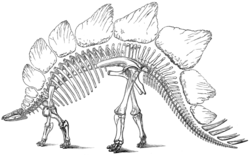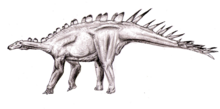Stegosauria
| Stegosauria | ||||||||||||
|---|---|---|---|---|---|---|---|---|---|---|---|---|

Model of Stegosaurus |
||||||||||||
| Temporal occurrence | ||||||||||||
| Middle Jurassic to Lower Cretaceous ( Bajocium to Albium ) | ||||||||||||
| 170.3 to 100.5 million years | ||||||||||||
| Locations | ||||||||||||
|
||||||||||||
| Systematics | ||||||||||||
|
||||||||||||
| Scientific name | ||||||||||||
| Stegosauria | ||||||||||||
| Marsh , 1877 |
The stegosauria ( Latinization from ancient Greek στέγος stégos 'roof' and σαῦρος sauros 'lizard'), German also stegosaurs , are a taxon of the bird pelvic dinosaur (Ornithischia). They are quadrupede (four-legged) herbivorous dinosaurs characterized by a double row of bony plates or spines along the back and top of the tail. The namesake and best known representative was Stegosaurus , but a total of over a dozen genera have been described.
features
General physique
Stegosaurs were medium-sized dinosaurs that reached a length of 3 to 9 meters. The front limbs were short and strong, the hind limbs long and columnar. The toes of each leg ended in wide hooves. In all stegosaurs (with the exception of the primitive Huayangosaurus ) the hind legs were significantly longer than the front legs, which brought them into a bent forward position and positioned their head close to the ground. The lower leg of the hind legs was also relatively short compared to the thigh. From this one concludes that these animals could only move slowly. The tail was long and was probably held horizontally.
Bone plates on the back
One of the greatest features of the Stegosauria was the bone plates (osteoderms) arranged in a double row along the back and tail. These differed considerably in their shape and serve as an important distinguishing feature of the individual genera. In some representatives (such as Stegosaurus and Lexovisaurus ) they were large, very thin, and leaf-shaped; in others (like Tuojiangosaurus ) rather conical and sometimes (like Kentrosaurus ) pointed and thorn-like. The bone plates were not directly connected to the skeleton, but stuck into the skin, so that their exact arrangement is unclear. At first it was assumed that they lay flat on the animals' backs like armor; However, recent finds suggest that they were erect. Whether they were arranged parallel or mutually offset is just as controversial as their function.
Originally they were mostly mistaken for a defensive weapon, but they seem too fragile and inconveniently placed for that, as they left the animal's sides unprotected. Other theories see a possibility for thermoregulation in the bone plates . This was supported by the fact that there are fine grooves in the large bone plates of Stegosaurus , which presumably housed blood vessels. The animals could have exposed their plates to the sun to let their body temperature rise faster, or they could have turned them away to cool. Studies have shown that the thermoregulatory effectiveness would have been greater with an offset arrangement of the plates than with a parallel one. Against these theories, the fact that the plates in many stegosaurs were not thin and leaf-shaped, but rather cone-shaped or spiky and thus unsuitable for thermoregulation.
More recent theories assume a visual function of the bone plates. Possibly they were displayed to establish group hierarchy or as a form of courtship behavior . There is no known gender dimorphism in the shape and size of the plates, but the finds are often too sparse to rule out that. Possibly the plates were also used to increase the apparent height of the animals in order to intimidate predators. Still other theories assume that the plates were used for identification. However, a combination of these functions is also possible.
Spines on tail and shoulder

All stegosaurs had one or more pairs of pointed spines at the tip of their tail, which, in contrast to the bone plates, were firmly attached to the skeleton. These spines were most likely used for defensive purposes, and by swinging the tail back and forth they could wound predators. Based on a cartoon by Gary Larson , the tail spines are referred to in English as "Thagomizer" in a semi-humorous way. Older depictions often show the tail spines pointing upwards, while more recent examinations tend to show a horizontal position, which would be far more effective for defense purposes.
The structure and function of the spines in the shoulder area is less clear. These are only known from some stegosaurs, such as Huayangosaurus , Tuojiangosaurus and particularly large Lexovisaurus and Gigantspinosaurus ; however, they are absent in Stegosaurus . With Kentrosaurus these spines are often suspected in the area of the pelvis , but that might be wrong. Whether these shoulder spikes were used for defense or visual purposes is debatable. A possible sexual dimorphism in the length of these spines in Lexovisaurus suggests the second possibility.
Head and teeth

The heads of the stegosaurs were small compared to the rest of the body and, due to the short front legs, positioned close to the ground. With the exception of the primitive Huayangosaurus , the skulls were slender and elongated. In Huayangosaurus the premaxillary (the foremost bone of the upper jaw) still had teeth, in the other stegosaurs it is toothless and has a sharp horned beak, which favored a selective foraging for food.
The teeth of the stegosaurs were small, roughly triangular and simply built. There are no pronounced chewing surfaces, which made it impossible to grind the food thoroughly. The muscle extension on the branch of the mandible (coronoid process) was only weakly developed, which suggests relatively weak masticatory muscles. Due to the inwardly indented position of the teeth, it is assumed that stegosaurs had cheeks.
The brain and the "second brain"
The stegosaurs' brain skulls were small and accordingly these animals have a common reputation for having only minimal mental abilities. In fact, the estimated brain mass was only 0.001% of body weight, but ankylosauria and sauropod had relatively smaller brains than stegosaurs. Casts of the cerebral shell are available from Stegosaurus and Kentrosaurus , these indicate a small, elongated brain, but in which the olfactory bulbs were well developed. The dimensions of dinosaur brains are not exactly known, however, as it is unclear whether the brain filled the entire cranium (which is not the case with lizards and crocodiles , but is the case with birds ). Conclusions about the intelligence of these animals are only possible to a limited extent, because on the one hand, due to the allometry, smaller animals often have comparatively larger brains. On the other hand, the fact that the stegosaurs survived at least 70 million years shows that their mental abilities were perfectly adequate for their lifestyle.
Soon after the animal was described, a large cavity was discovered in the pelvic region of the vertebral canal that could house a structure up to 20 times larger than the brain. This led to the famous idea that the stegosaur had a kind of "second brain" at the base of the tail, which should have served to control reflexes in the back of the body. While the idea of a “second brain” is unanimously rejected today, the thesis was expressed that this cavity could have housed a glycogen body, which is also found in the same form in today's birds. Glycogen is the storage form of carbohydrates and is used for the short to medium term storage and provision of the energy carrier glucose . The cavity could have been used to supply the nervous system, but the exact function is not known.
Assumed way of life
Social behavior and development
Compared to other dinosaur groups, only relatively few fossils have survived from the stegosaurs , which hardly allow any conclusions to be drawn about the social behavior of these animals.
Only from Kentrosaurus were the remains of several animals found together, which may indicate an at least temporary herd formation. These data are missing for the other species. As mentioned above, the bone plates and the shoulder spikes could have served visual communication - the establishment of a hierarchy or courtship behavior. Slight signs of sexual dimorphism (the length of the shoulder spines and differences in the number of ribs ) can also point in this direction; the findings are simply lacking for more precise guesses.
Little is known about the individual development of the stegosauria either. There are no finds of nests, eggs, eggshells or hatchlings. Young animals have only been passed down from a few genera.
nutrition
The low positioned head and the teeth suggest that stegosauria mainly fed on plants close to the ground (up to 1 meter in height). Presumably they ate mosses , ferns , cycads , conifers or fruits. According to one theory, stegosaurs could stand up on their hind legs, propping themselves up with their tails and thus reach food up to 6 meters high. Other researchers, on the other hand, believe that erecting is not possible due to the structure of the tail.
As mentioned above, the teeth were small and unsuitable for grinding and the masticatory muscles were rather weak. The exact methods of food processing are still unclear, especially since, in contrast to other herbivorous dinosaurs, no gastroliths (stomach stones) were found in them.
History of discovery and research
The earliest stegosaur finds were made in England in the mid-19th century and examined by Owen , Mantell and Seeley , among others . Due to the dismembered condition of the finds, no precise information could be given about these animals - these are the stegosaurs known today as Dacentrurus and Lexovisaurus .
At the end of the 19th century, Othniel Charles Marsh discovered numerous remains of Stegosaurus in the Morrison Formation in North America and was thus able to create a more precise picture of these animals for the first time. Charles Gilmore published the first detailed study of stegosaurs in 1914. The next important find was the Kentrosaurus by the African Tendaguru expedition under Werner Janensch shortly before the First World War.
After the Second World War, the first Chinese stegosaurs came to light; The Shaximiao Formation in Sichuan , in which Chialingosaurus , Tuojiangosaurus and Huayangosaurus were brought to light , was particularly productive . The most recent finds so far are Hesperosaurus , which was again excavated in 2001 in the Morrison Formation, and Miragaia from Portugal.
Systematic and cladistic studies of these animals were mainly carried out by Peter Galton and Paul Upchurch and Paul Sereno and Dong Zhiming.
Distribution and history of development
Well-preserved fossil finds of the Stegosauria are known from North America, Western Europe, East Asia and Africa; Footprints ( Ichnofossils ) and single bones also from South America and Australia, so that a worldwide distribution of these animals can be assumed. In paleobiogeographical terms, this distribution can also be explained by the fact that the supercontinent of Pangea had only broken up a little, if at all, at that time, which is why they were able to expand largely unhindered.
The earliest possible traces of the stegosauria come from the lower Jurassic ( Hettangium about 198 million years ago). However, these are controversial footprints. The oldest single bone finds come from the Middle Jurassic ( Bajocium ). The oldest better known representative was Huayangosaurus , which lived about 170 to 168 million years ago. The stegosauria experienced their heyday in the Upper Jurassic (163 to 145 million years ago), from this time there are almost worldwide finds.
A few examples have survived from the early Lower Cretaceous as well, albeit on a sparse scale. One of the last known representatives is Wuerhosaurus , which became extinct about 100 million years ago. It is possible that the ankylosauria that developed in the Cretaceous period and that perhaps occupied similar ecological niches displaced the stegosauria. The youngest stegosaur find, Dravidosaurus , around 85 million years old, from India is controversial . It is conceivable that the stegosaurs in the geographical isolation of India during the Cretaceous Period (the subcontinent was an island at the time) could have survived longer than elsewhere, but the findings of Dravidosaurus are very poorly preserved and some researchers believe that it is a plesiosaur .
The stegosauria almost certainly did not experience the mass extinction of the dinosaurs at the end of the Cretaceous period.
Systematics
External system
The sister group of the Stegosauria are the Ankylosauria , which were also covered with bone plates, but which took the form of armor with them. Stegosauria and Ankylosauria together form the taxon Eurypoda . Together with some primitive representatives from the Lower Jurassic (for example Scutellosaurus and Scelidosaurus ), the Eurypoda form the taxon of the Thyreophora ("shield bearer"). These are classified in the bird pelvic dinosaur (Ornithischia). A simplified cladogram that shows only the most important taxa looks like this:
| Dinosauria |
|
||||||||||||||||||||||||
|
|
Internal system
The stegosaurs are a well-documented monophyletic group. They can be divided into two families, the Huayangosauridae (with Huayangosaurus as the only representative) and the Stegosauridae, which combine the other species. The Huayangosauridae differ from the other stegosaurs, among other things, in that the premaxillary (the foremost bone of the upper jaw) still had teeth and the front legs were approximately the same length as the rear legs.
Within the Stegosauridae, Dacentrurus and probably also Chungkingosaurus are considered to be basic representatives, the other species are grouped together as Stegosaurinae. The parentage relationships within the Stegosaurinae are largely unexplained.
The stegosauria include the following genera:
Stegosauria
- Huayangosauridae
- Stegosauridae
- Adratiklit
- Chungkingosaurus ?
- Dacentrurinae
- Stegosaurinae
- Incertae sedis (assignment unclear)
- Nomina dubia (finds too few for a more precise classification)
literature
- Peter M. Galton , Paul Upchurch : Stegosauria. In: David B. Weishampel , Peter Dodson , Halszka Osmólska (eds.): The Dinosauria . 2nd edition. University of California Press, Berkeley CA et al. 2004, ISBN 0-520-24209-2 , pp. 343-362.
- David E. Fastovsky , David B. Weishampel: The Evolution and Extinction of the Dinosaurs. 2nd edition. Cambridge University Press, Cambridge et al. 2005, ISBN 0-521-81172-4 .
Individual evidence
- ^ Gregory S. Paul : The Princeton Field Guide To Dinosaurs. Princeton University Press, Princeton NJ et al. 2010, ISBN 978-0-691-13720-9 , pp. 218-226, online .
- ^ Wilhelm Gemoll : Greek-German school and hand dictionary. 9th edition, reviewed and expanded by Karl Vretska ; with an introduction to the history of language by Heinz Kronasser. Freytag et al., Munich et al. 1965.
- ↑ Ben Creisler: Dinosauria Translation and Pronunciation Guide. Archived from the original on July 20, 2011 ; Retrieved December 3, 2013 .
- ↑ Fastovsky & Weishampel (2005), p. 120
- ↑ Hillary Mayell: Stegosaur plates used for identification. In: National Geographic News , May 25, 2005.
- ↑ see Thagomizer in the English Wikipedia
- ↑ Fastovsky & Weishampel (2005), p. 114
- ↑ after Fastovsky & Weishampel (2005)
- ↑ after Galton & Upchurch (2004)
- ↑ Susannah CR Maidment, Thomas J. Raven, Driss Ouarhache, and Paul M. Barrett. 2019. North Africa's First Stegosaur: Implications for Gondwanan Thyreophoran Dinosaur Diversity. Gondwana Research. DOI: 10.1016 / j.gr.2019.07.007
- ↑ Octávio Mateus, Susannah CR Maidment, Nicolai A. Christiansen: A new long-necked "sauropod-mimic" stegosaur and the evolution of the plated dinosaurs. In: Proceedings of the Royal Society. Series B: Biological Sciences. Vol. 276, No. 1663, 2009, ISSN 0950-1193 , pp. 1815-1821, doi : 10.1098 / rspb.2008.1909 .





